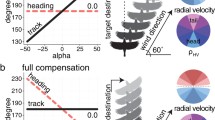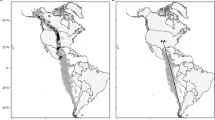Abstract
Migratory movements in air or water are strongly affected by wind and ocean currents and an animal which does not compensate for lateral flow will be drifted from its intended direction of movement. We investigated whether arctic shorebirds during autumn migration in the region of South Sweden and the southern Baltic Sea compensate for wind drift or allow themselves to be drifted when approaching a known goal area under different circumstances (over sea, over land, at low and high altitude) using two different approaches, visual telescope observations and tracking radar. The shorebirds showed clearly different responses to crosswinds along this short section (<200 km) of the migratory journey, from almost full drift when departing over the sea, followed by partial drift and almost full compensation at higher altitudes over land during later stages. Our study demonstrates that shorebirds are also remarkably variable in their response to crosswinds during short sections of their migratory journey. The recorded initial drift close to departure is probably not adaptive but rather a result of constraints in the capacity of the birds to compensate in some situations, e.g. in low-altitude climbing flight over the sea. We found no difference in orientation response to wind between adult and juvenile birds. This study indicates, in addition to adaptive orientation responses to wind, the importance of the non-adaptive wind drift that contributes to increasing the variability of drift/compensation behaviour between places that are separated by only short distances, depending on the local topographic and environmental conditions.
Zusammenfassung
Orientierung von Watvögeln im Verhältnis zum Wind: sowohl Drift als auch Kompensation in derselben Region
Zugbewegungen in der Luft oder im Wasser sind stark beeinflusst durch Wind oder Meeresströmungen, und ein Tier, das einen seitlichen Versatz nicht ausgleichen kann, wird von seiner angestrebten Bewegungsrichtung abgetrieben. Wir untersuchten, ob arktische Watvögel während des Herbstzugs in Südschweden und der südlichen Ostsee ihren Versatz durch Wind ausgleichen oder es zulassen, abgetrieben zu werden, wenn sie ein bekanntes Zielgebiet unter verschiedenen Bedingungen erreichen können (über See, über Land, in geringer oder großer Höhe). Wir setzten sowohl visuelle Beobachtung mit Teleskopen als auch Radartracking ein. Die Watvögel zeigten deutlich unterschiedliche Reaktionen auf Seitenwinde über diesen kurzen Abschnitt (<200 km) ihrer Zugroute, von fast vollständigem Abtreiben beim Aufbruch über See, gefolgt von einer teilweisen Drift und fast vollständigem Ausgleich der Seitenwinde bei größeren Höhen über Land während späterer Abschnitte. Unsere Untersuchung zeigt, dass Watvögel auch über kurze Abschnitte ihrer Zugroute bemerkenswert variabel sind in ihrer Reaktion auf Seitenwinde. Die festgestellte anfängliche Drift kurz nach dem Abflug ist wahrscheinlich keine Anpassungsleistung, sondern Einschränkung in der Möglichkeit der Vögel zum Ausgleich in bestimmten Situationen geschuldet, zum Beispiel im Steigflug in geringer Höhe über See. Wir fanden keine Unterschiede in der Reaktion auf Seitenwinde zwischen adulten und juvenilen Vögeln. Diese Untersuchung zeigt die Wichtigkeit nicht-adaptiver Wind-Drift, die neben adaptiven Reaktionen auf Seitenwinde die Variabilität des Drift/Kompensations-Verhaltens auch zwischen eng beieinander liegenden Orten beeinflusst.


Similar content being viewed by others
References
Alerstam T (1976) Bird migration in relation to wind and topography. Dissertation, Lund University
Alerstam T (1979) Wind as selective agent in bird migration. Ornis Scand 10:76–93
Alerstam T (1985) Strategies of migratory flight, illustrated by arctic and common terns, Sterna paradisaea and Sterna hirundo. In: Rankin MA (ed) Migration: mechanisms and adaptive significance, Contrib Mar Sci 27:580–603
Alerstam T, Pettersson SG (1976) Do birds use waves for orientation when migrating across the sea? Nature 259:205–207
Batschelet E (1981) Circular statistics in biology. Academic, London
Chapman JW, Klaassen RHG, Drake VA, Fossette S, Hays GC, Metcalfe JD, Reynolds M, Reynolds DR, Alerstam T (2011) Animal orientation strategies for movement in flows. Curr Biol 21:R861–R870
Fransson T, Österblom H, Hall-Karlsson S (2008) Swedish Bird Ringing Atlas, vol 2. Bulls Graphics, Halmstad
Green M (2001) Is wind drift in migrating barnacle and brent geese Branta Leucopsis and Branta bernicla, adaptive or non-adaptive? Behav Ecol Sociobiol 50:45–54
Green M, Alerstam T (2002) The problem of estimating wind drift in migrating birds. J Theor Biol 218:485–496
Green M, Alerstam T, Gudmundsson GA, Hedenström A, Piersma T (2004) Do arctic waders use adaptive wind drift? J Avian Biol 35:305–315
Grönroos J, Green M, Alerstam T (2012a) To fly or not to fly depending on winds: shorebird migration in different seasonal wind regimes. Anim Behav 83:1449–1457
Grönroos J, Green M, Alerstam T (2012b) Fine-scaled orientation changes in migrating shorebirds. Ardea 100:45–53
Gudmundsson GA (1994) Spring migration of the knot Calidris c. canutus over southern Scandinavia, as recorded by radar. J Avian Biol 25:15–26
Kemp MU, van Shamoun-Baranes J, van Gasteren H, Bouten W, van Loon E (2010) Can wind help explain seasonal differences in avian migration speed? J Avian Biol 41:672–677
Klaassen RHG, Hake M, Strandberg R, Alerstam T (2011a) Geographical and temporal flexibility in the response to crosswinds by migrating raptors. Proc R Soc Lond B 278:1339–1346
Klaassen RHG, Alerstam T, Carlsson P, Fox JW, Lindström Å (2011b) Great flights by great snipes: long and fast non-stop migration over benign habitats. Biol Lett 7:833–835
Liechti F (2006) Birds: blowin´ by the wind? J Ornithol 147:202–211
Richardson WJ (1979) South-eastward shorebird migration over Nova Scotia and New Brunswick in autumn: a radar study. Can J Zool 57:107–124
Richardson WJ (1991) Wind and orientation of migrating birds: a review. In: Berthold P (ed) Orientation in birds. Birkhäuser, Basel, pp 226–249
Sutton OG (1953) Micrometeorology. McGraw-Hill, New York
Thorup K, Alerstam T, Hake M, Kjellén N (2003) Bird orientation: compensation for wind drift in migrating raptors is age dependent. Proc R Soc Lond B 270:S8–S11
Williams TC, Williams JM, Kloeckner PD (1986) Airspeed and heading of autumnal migrants over Hawaii. Auk 103:634–635
Acknowledgments
We are very grateful to the staff at Ottenby Bird Observatory, especially Petter Olsson, for trapping Dunlin. We would also like to thank Janne Dahlén, Anton Arnesson and Christian Cederroth for their help in the field at Ottenby. J.G. obtained Ph.D. support from grants to Susanne Åkesson for which we are very grateful. Permission to perform this study was given by the Ethical Committee of Lund University (permissions no 14204-06 and 1427-10). One anonymous referee provided valuable comments on an earlier version of this manuscript. This study was financed by the Swedish Ornithological Society, Lunds Djurskyddsfond, Helge Ax:son Johnssons stiftelse, Lars Hiertas minne, the Royal Swedish Academy of Science and the Royal Physiographic Society in Lund (grants to J.G.). The study was further supported by the Swedish Research Council (to T.A.). The authors declare that they have no conflict of interest. This is report no. 260 from Ottenby Bird Observatory.
Author information
Authors and Affiliations
Corresponding author
Additional information
Communicated by F. Bairlein.
Rights and permissions
About this article
Cite this article
Grönroos, J., Green, M. & Alerstam, T. Orientation of shorebirds in relation to wind: both drift and compensation in the same region. J Ornithol 154, 385–392 (2013). https://doi.org/10.1007/s10336-012-0902-7
Received:
Revised:
Accepted:
Published:
Issue Date:
DOI: https://doi.org/10.1007/s10336-012-0902-7




